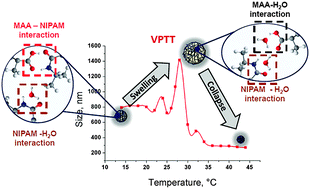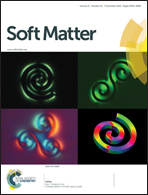Unusual temperature-induced swelling of ionizable poly(N-isopropylacrylamide)-based microgels: experimental and theoretical insights into its molecular origin†
Abstract
In the traditional view of temperature-driven volume phase transitions in PNIPAM-based microgel solutions, a monotonic and sharp decrease in the particle size occurs upon heating the solution to above the volume phase transition temperature (VPTT). However, at sufficiently high microgel concentrations and under low salt conditions, our dynamic light scattering experiments reveal an unexpected non-monotonic evolution of the particle size when increasing the solution temperature. These findings show that poly(N-isopropylacrylamide-co-methacrylic acid) (P(NIPAM-co-MAA)) microgels swell upon heating the solution in the temperature range where NIPAM is water-soluble (i.e., below the VPPT). Further heating the microgel solution leads to microgel collapse as typically observed at temperatures above the VPTT. This novel behavior depends on the particle and salt concentration. We have observed the expected monotonic temperature-response of P(NIPAm-co-MAA) microgel solutions at low particle density and high salt concentration. To gain insights into the molecular origin of the unusual behavior of these microgel solutions, we have combined nuclear magnetic resonance studies and molecular-level theoretical calculations of the system. A delicate balance between inter-particle steric compressions and intra-microgel physical interactions and chemical equilibria determines the size of these microgels. Both steric compression, due to finite density, and hydrogen bond formation in the interior of the microgels favors a more compact particle. On the contrary, at the pH of the experiments the acid–base equilibrium constrains the polymer charge to increase, which favors particle swelling due to intra-microgel electrostatic repulsions. This interplay between physical interactions and chemical equilibria occurring at the nanometer length-scale determines the unusual thermal-induced swelling of P(NIPAM-co-MAA) microgels.


 Please wait while we load your content...
Please wait while we load your content...